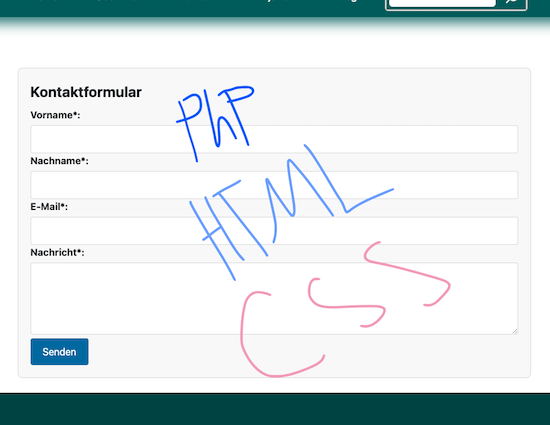🔧 1. Shortcode-Funktion in functions.php registrieren
// kontaktformular per shortcode laden
function mein_kontaktformular_shortcode() {
ob_start();
require get_stylesheet_directory() . '/parts/php/kontaktformular.php'; // Pfad anpassen
return ob_get_clean();
}
add_shortcode('kontaktformular', 'mein_kontaktformular_shortcode');
📌 Was das macht:
- Gibt deren Inhalt zurück, wenn du
[kontaktformular]im Editor verwendest. - Lädt die Datei
kontaktformular.phpaus dem Unterordner/parts/php/deines Child-Themes.
🎨 2. CSS-Datei einbinden (contact.css)
function kontaktformular_styling() {
wp_enqueue_style(
'kontaktformular-style',
get_stylesheet_directory_uri() . '/custom-styles/contact.css' // Pfad zur CSS-Datei
);
}
add_action('wp_enqueue_scripts', 'kontaktformular_styling');
📌 Hinweis:
Lege die Datei contact.css im Verzeichnis /custom-styles/ deines Child-Themes an.
3. Datei kontaktformular.php in /parts/php/ anlegen
<?php
$empfaenger = 'info@example.com'; // E-Mail-Adresse des Admins
$fehler = '';
$erfolg = '';
if ($_SERVER["REQUEST_METHOD"] === "POST" && isset($_POST['kontaktseite_nonce']) && wp_verify_nonce($_POST['kontaktseite_nonce'], 'kontaktformular_absenden')) {
$vorname = sanitize_text_field($_POST['vorname']);
$nachname = sanitize_text_field($_POST['nachname']);
$email = sanitize_email($_POST['email']);
$nachricht = sanitize_textarea_field($_POST['nachricht']);
if (empty($vorname) || empty($nachname) || empty($email) || empty($nachricht)) {
$fehler = 'Bitte füllen Sie alle Pflichtfelder aus.';
} elseif (!is_email($email)) {
$fehler = 'Bitte geben Sie eine gültige E-Mail-Adresse ein.';
} else {
$betreff = 'Kontaktformular-Anfrage von ' . $vorname . ' ' . $nachname;
$inhalt = "Vorname: $vorname\nNachname: $nachname\nE-Mail: $email\nNachricht:\n$nachricht";
$headers = [
'Content-Type: text/plain; charset=UTF-8',
"From: $vorname $nachname <$email>"
];
// Bestätigung an den Absender
$confirmation_subject = 'Bestätigung: Ihre Nachricht wurde erfolgreich gesendet';
$confirmation_body = "Hallo $vorname,\n\nvielen Dank für Ihre Nachricht. Wir melden uns bald bei Ihnen.\n\nIhre Nachricht war:\n$nachricht";
wp_mail($email, $confirmation_subject, $confirmation_body, $headers);
// Mail an Admin
if (wp_mail($empfaenger, $betreff, $inhalt, $headers)) {
wp_safe_redirect(home_url('/danke/'));
exit;
} else {
$fehler = 'Beim Senden ist ein Fehler aufgetreten.';
}
}
}
?>
Ergänze die Datei kontaktformular.php ganz unten um folgenden Html-Code. :
<div class="kontaktformular">
<h1>Kontaktformular</h1>
<?php if ($fehler): ?>
<p style="color:red;"><?php echo esc_html($fehler); ?></p>
<?php endif; ?>
<?php if ($erfolg): ?>
<p style="color:green;"><?php echo esc_html($erfolg); ?></p>
<?php endif; ?>
<form action="<?php echo esc_url(get_permalink()); ?>" method="post">
<?php wp_nonce_field('kontaktformular_absenden', 'kontaktseite_nonce'); ?>
<p>
<label for="vorname">Vorname*:</label><br>
<input type="text" name="vorname" id="vorname" required>
</p>
<p>
<label for="nachname">Nachname*:</label><br>
<input type="text" name="nachname" id="nachname" required>
</p>
<p>
<label for="email">E-Mail*:</label><br>
<input type="email" name="email" id="email" required>
</p>
<p>
<label for="nachricht">Nachricht*:</label><br>
<textarea name="nachricht" id="nachricht" rows="5" required></textarea>
</p>
<p>
<button type="submit">Absenden</button>
</p>
</form>
</div>
4. CSS für contact.css erstellen
.kontaktformular {
max-width: 600px;
margin: 0 auto;
padding: 2rem;
background-color: #f9f9f9;
border-radius: 12px;
box-shadow: 0 4px 12px rgba(0, 0, 0, 0.1);
font-family: system-ui, sans-serif;
}
.kontaktformular h1 {
text-align: center;
font-size: 1.75rem;
margin-bottom: 1.5rem;
color: #333;
}
.kontaktformular label {
display: block;
margin-bottom: 0.25rem;
font-weight: 600;
color: #444;
}
.kontaktformular input,
.kontaktformular textarea {
width: 100%;
padding: 0.75rem;
margin-bottom: 1rem;
border: 1px solid #ccc;
border-radius: 8px;
font-size: 1rem;
box-sizing: border-box;
}
.kontaktformular textarea {
resize: vertical;
min-height: 150px;
}
.kontaktformular button {
background-color: #0073aa;
color: #fff;
border: none;
cursor: pointer;
font-weight: bold;
padding: 0.75rem 1.5rem;
border-radius: 8px;
font-size: 1rem;
transition: background-color 0.3s ease;
}
.kontaktformular button:hover {
background-color: #005f8d;
}
5. Formular in Gutenberg einfügen
- Öffne deine Seite „Kontakt“ im Block-Editor (Gutenberg).
- Füge einen „Shortcode“-Block ein.
- Trage dort den Shortcode ein:
[kontaktformular]
✅ Ergebnis
- Kontaktformular wird auf der Seite angezeigt.
- E-Mails gehen an den Website-Betreiber und eine Bestätigung an den Absender.
- Nach Absenden erfolgt eine Weiterleitung zur Danke-Seite (
/danke/– du musst diese Seite anlegen!).
🔒 Sicherheitshinweis
- Durch
wp_verify_nonceist das Formular vor CSRF-Angriffen geschützt. - Mit
sanitize_…()werden alle Eingaben gesichert verarbeitet.

Leave a Reply